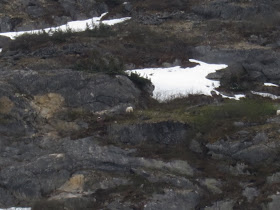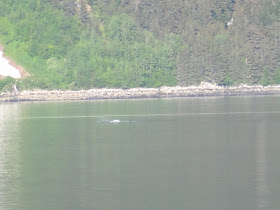Here you can see Moose teeth marks.

We hike through the valley that has been carved by Exit Glacier. It is amazing how much the glacier has receded over the years. Even as we were driving up the highway to the glacier, we see signs with numbers on them... 1892....1908... These show where the glacier extended to that year.


Sometimes you can find snow with a reddish tint.
It's hard to see in this photo, but in the lower left there is some 'weird' looking snow that was slightly pink. This snow has a bacteria living in it that turns it the reddish hue, and is sometimes referred to as "watermelon snow". Ice worms live off this bacteria. Ice worms have to stay around 0 - 4 C. If you held one in your hand, it would literally melt from overheating.

So that is Exit Glacier. You can feel the wind coming down from the ice fields. It is named Exit Glacier because that is where some explorers existed from the ice fields, skiing down the glacier.
After visiting Exit Glacier, we head north into Alaska, stopping for a visit at a Wildlife Preserve.
Lots of animals here. Most of these animals were brought here after being found injured. Some of the animals here were once thought to be extinct. The preserve is trying to re-establish the population of the endangered species.
What's the difference between a caribou and a reindeer?
Caribou are wild.
Reindeer are domesticated.


Also, we learned that the mosquito really is the Alaskan state bird. I know, you probably thought it was the Ptarmigan, but you'd be wrong. Speaking of birds, here is an eagle that cannot fly. Poor eagle.

For the evening, we stay in the Alyeska Resort, a very nice ski lodge. We ride a lift up to check out the view.















































